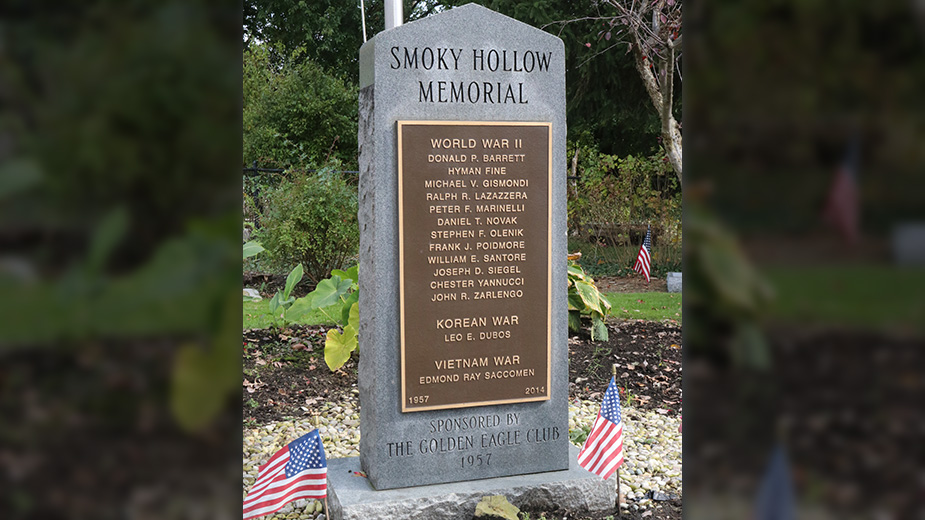YOUNGSTOWN, Ohio – Not far from Youngstown State University, the Smoky Hollow War Memorial stands as a testament to the young men who once lived in the immigrant, working-class neighborhood.
As a 10-year-old boy in 1957, Gerald Nunziato attended a Golden Eagle Club ceremony to dedicate the memorial. The club was formed by boys in the neighborhood during the Depression. Nunziato’s father served as president of the club, which sent many of its members to the armed forces.
After the war, Nunziato says the club funded and installed the memorial listing those killed or declared missing in action in the Second World War and the Korean Conflict.
Smoky Hollow was a melting pot of those who came to Youngstown looking for a better life. Once a densely populated neighborhood, Smoky Hollow’s name articulated the haze wafting from the nearby Mahoning Valley Iron Co.
Almost all residents of Smoky Hollow – which is bounded by Wick, Rayen and Andrews avenues – eventually left the old neighborhood, including Nunziato in 1970.
But when he returned to attend a Memorial Day service at the Smoky Hollow War Memorial, he found the few remaining Golden Eagle members could not recall the stories of the men on the monument.

So Nunziato began asking himself a couple of questions. Why in 2009 was there a name, Joseph D. Siegel, being read aloud that was not listed on the monument? And who were these young men?
Partnering with his good friend, Felix “Lee” Lazazzera, whom Nunziato says “kew everyone,” the two men set out to find answers.
They conducted research for 10 years at the Public Library of Youngstown and Mahoning County, the Mahoning Valley Historical Society and the Jewish Community Center’s library. They also pored overfragments of information in unexpected places like a local soup kitchen and from members of a card club and reached out to places outside the area.
Nunziato and Lazazzera were able to track down the stories of the fallen veterans and sometimes their family members.
The sister of one soldier verified the 1957 monument incorrectly lists a Donald Novak instead of Daniel Novak.
Donald Novak had served in World War II but died 10 years after it in Youngstown. The monument was updated in 2014, not just to reflect that change, but to add Siegel and a Vietnam War casualty, Edmond Ray Saccomen, who attended The Rayen School with Nunziato.
Siegel was found to be the first Youngstown Vindicator employee to die in World War II and is buried in Arlington National Cemetery. Siegel’s sister-in-law in Santa Monica, Calif., never met him, but has a son named after him. She came to Youngstown to see the monument after hearing from Nunziato.
Mary Fusco DiPizzo was engaged to the Peter Marinelli listed on the monument and provided fond memories of a dance in Girard and personal letters sent across the ocean during the war.
Seaman Chester Yannucci, also known by friends at Campbell Memorial High School as “Tuba Ruba,” was a musician and died when the U.S.S. Houston was sunk by the Japanese.
Stephen Olenik and Hyman Fine were found to have both died following the German bombing of a mess hall in Eygelshoven, The Netherlands. Nunziato obtained the diary of a Dutch priest who gave last rites at the scene.
John R. Zarlengo was born in Italy and lived 17 years in Smoky Hollow. He was killed during the invasion of Normandy at the age of 23.
Nunziato now has volumes of research dedicated to the stories of these young men. Posters created in their honor can be found hanging in local establishments like Yosteria, a restaurant in Smoky Hollow, and the YSU Veterans Resource Center, which is named in honor of his brother, Carl A. Nunziato.

World War I veterans are not included on the current Smoky Hollow monument. But Nunziato’s latest research project is aimed at finding the stories of nine WW I service members from the neighborhood.
Nunziato declined to have his photo taken during a recent visit to his home. He is happy to share his research, although he notes these are sad stories.
He hopes funding can be found to memorialize those World War I soldiers at the site, which is now cared for by Youngstown CityScape.
“This is important to know about these soldiers,” says Nunziato, who served as a Marine reservist, and dedicated his retirement to this project. “I wish more people would do this. It’s disappearing. The average age of guys [who were] in Vietnam is probably 70 years old. If we don’t do it, we lose history.”
Pictured at top: Research led to the 2014 update of the monument.
